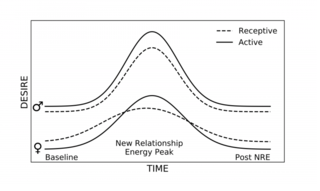Sex
The Rise and Inevitable Fall of New Relationship Energy
Learn how to ride the waves of desire.
Posted February 25, 2021 Reviewed by Gary Drevitch
- New relationship energy (NRE) refers to the intense passion that is common in a new relationship.
- Desire quickly ramps up due to changes in signals in the brain, but eventually, habituation kicks in and our brain chemistry settles down.
- When we forget our baseline level of desire, comparing the high of NRE to its eventual decline can feel like a loss or falling out of love.
Are you familiar with the honeymoon period of a relationship? That ecstatic, crazy-in-love period of a new relationship when all you want to do is rip each other's clothes off and make love 24/7? When you seem to be aroused by the mere sound of his voice? The scent of her perfume or skin? Sex during this phase is intense, passionate, and seems so, so easy (for most)! Then after a few months or years, the excitement seems to wear off. You're no longer new to each other. Alas, some people even think they are no longer in love.
What I’ve just described is the phenomenon called “new relationship energy” or NRE. And it eventually decreases and may even totally wear off. It’s not because people fall out of love; it’s because the neurochemical cocktail that fuels the ecstatic feelings and nonstop lust naturally winds down. Over the past several years, researchers have begun to identify not only the brain areas related to new relationship energy (NRE) but also the neurochemicals involved. The major areas identified include the ventral tegmentum, the amygdala, and the hippocampus – all areas that play roles in our reward pathway.
The Brain on New Relationship Energy
What's going on when we are revved up on NRE? Here are some insights from my book, Why Good Sex Matters: Understanding the Neuroscience of Pleasure for a Smarter, Happier, and More Purpose-Filled Life: Dopamine is flooding our system and all we do is want, want, want. Sound familiar? At the same time, we are experiencing high levels of oxytocin and vasopressin – which is reinforced with ever more sensual contact. And even cortisol levels become elevated since falling into love is a kind of stressor as the individual goes through the concerns and potential insecurities about the new relationship. NRE is also associated with decreased levels of serotonin, cueing up the not so delightful tendency of ruminating that can be the dark side of NRE, where the person obsessively thinks about the partner (incidentally, people who suffer from Obsessive-Compulsive Disorder tend to have lower levels of serotonin which reverse after successful treatment).
Another finding is that levels of nerve growth factor (NGF), a neurotrophin, (a protein involved in the survival, development, and function of brain cells) ramps up during the early passionate stages of love. It appears the NGF release is a kind of stress reaction, too, and that the higher levels of NGF measured correlate with the highest ratings on the Passionate Love Scale. So, there are lots of juicy chemicals at work that render NRE a state of big highs, and if things don't go so well, potentially big lows, too.
Think of NRE like a biological highlighter. It quickly ramps up our desire set point to record highs. It powerfully focuses our attention on the new lover — increasing our interest and motivation to get to know the person, find out if there is more than just chemistry in the attraction, and then ultimately settle in, if all goes well, to do the work of bonding to build a sustainable relationship. People with high levels of seeking may be more susceptible to chasing the NRE buzz (what I call new relationship euphoria or even new relationship folly). What also is vastly misunderstood is that NRE tends to ramp up spontaneous desire well over baseline, while responsive desire remains intact.
Coming Down from Record-High Desire
When people confuse NRE with love, they leave old comfortable partnerships for the excitement of the next hit of NRE. I always, always tell people not to make big decisions or operate heavy machinery while under the influence of the potent neuropeptides of NRE.
Eventually, with time, the process of habituation kicks in (think of it as a relationship variant of the hedonic treadmill), and the brain chemistry settles down. As we bond with the person, the care system takes over with its nutritious and satisfying (but not electrifying) neurochemicals. Our desire set points return to baseline.
As NRE settles down, we may feel a big loss as we compare our ramped-up desire point relative to baseline. This is essentially what happens in the process of the Desire Curve. We forget about our original baseline desire and just compare the peak to what we experience after NRE resolves. We feel a loss. We feel a lack. Partners who enjoyed being pursued for sex feel abandoned when the sizzle subsides. Grown men whine that their women don't crave sex with them or want them anymore. Women feel deficient if they are no longer so intensely motivated to have sex. Even men can feel that their sexuality is somehow diminished as they return to baseline and are no longer fueled by the ramped-up lust of NRE.
This inevitable variability – the movement from your emotional and sexual set point to a high point of NRE and then back down to your baseline – encompasses what I call your Desire Curve. This curve, represented by the graph below, shows how your sexual baseline intersects with NRE, and also how men and women differ regarding spontaneous/active desire and receptive/passive desire.

You will note that the general levels of spontaneous and receptive desire are higher, overall, for men. And for men, the receptive desire levels are quite similar to those of spontaneous desire. For both sexes, spontaneous desire peaks at the apex of new relationship energy (in the throes of the new love where passions run high). For women, unlike men, the only time when spontaneous desire consistently exceeds receptive desire (other than during ovulation, which is not shown) is at peak NRE. For women, receptive desire is higher than the spontaneous desire for most of the curve. And finally, for both sexes, you will notice that both spontaneous and receptive desire return to a baseline quite similar to that which preceded the NRE.
The critical takeaway point here is that you need to be aware of the flow of both spontaneous and receptive desire over the course of the Desire Curve—and recognize the tendency is to forget about the original desire set point. By recalling the original desire set point and comparing the post-NRE set-point with the original, rather than comparing it with that at peak NRE, you will do much to counter the illusion that your return to baseline is an actual loss overall.
Facebook image: Stockbusters/Shutterstock
References
Wise, N. (2020). Why Good Sex Matters: Understanding the Neuroscience of Pleasure for a Smarter, Happier, and More Purpose-filled Life. Houghton Mifflin.




